Easy Homemade Basil Oil Recipe: Your Secret Ingredient for Vibrant Meals
Imagine a condiment so bright, so herbaceous, with a delightful punch of garlic and a fresh, zesty lemon zing that it instantly elevates any dish. This homemade basil oil is exactly that—a true flavor bomb you’ll find yourself drizzling on absolutely everything. It’s incredibly versatile, perfect for pasta dishes, crisp salads, grilled vegetables, savory sandwiches, and so much more. Best of all, it’s the most delicious and efficient way to use up all those fresh basil leaves, ensuring no aromatic herb goes to waste.
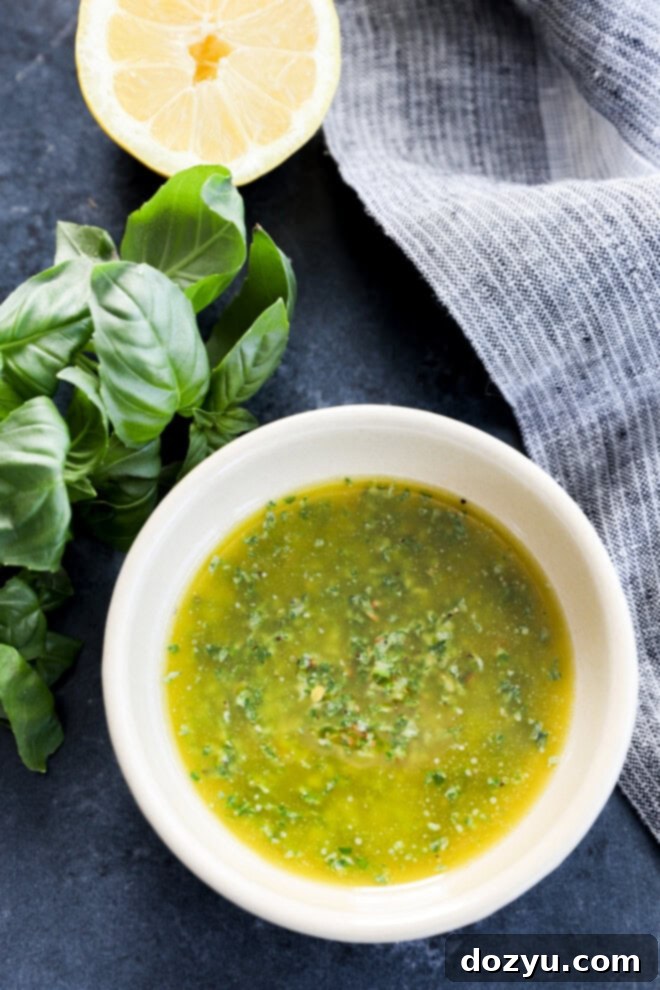
Table of Contents
About This Flavorful Basil Oil
This basil oil recipe is a testament to mindful cooking and zero-waste principles. Have you ever found a bunch of fresh basil in your fridge looking a little tired or wilted, threatening to go bad? Before you even think about tossing it, consider this delicious alternative: transform those leftover leaves into a vibrant, fresh, and incredibly flavorful basil oil. It’s a culinary hack that not only saves your herbs but also adds a touch of gourmet flair to your everyday meals.
More than just a condiment, this basil oil becomes one of those indispensable kitchen staples that effortlessly elevates ordinary dishes into something truly special. A simple drizzle over roasted vegetables can awaken their flavors, a swirl into a warm pasta dish creates an aromatic experience, and it can even revitalize forgotten leftovers. Its bright profile offers an easy hit of fresh, herbaceous flavor wherever your cooking needs a boost. You can keep a jar of this liquid gold in your refrigerator for quick, everyday use, or, even better, freeze it in small portions. This way, you’ll have the vibrant essence of summer basil ready to go, no matter the season, making it an excellent way to capture and enjoy those fleeting fresh flavors throughout the year.
This recipe is not only quick to prepare, but it’s also remarkably versatile and an incredibly smart way to maximize the lifespan and utility of your fresh herbs. Once you discover the convenience and deliciousness of having a jar of homemade basil oil on hand, you’ll likely wonder how you ever managed to cook without it. It’s a simple addition that delivers a profound impact on your culinary repertoire.
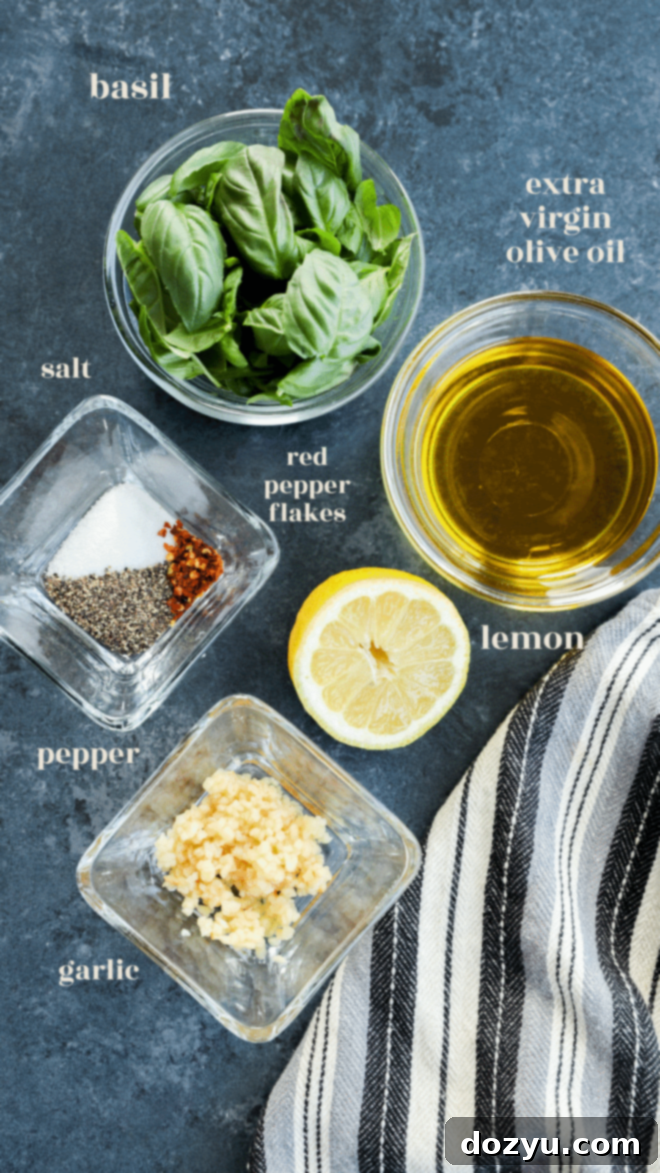
Essential Ingredients for Basil Oil
Creating truly exceptional basil oil relies on a few high-quality, fresh ingredients. Here’s a closer look at what you’ll need and why each component is crucial:
- Fresh Basil Leaves: The absolute star of this recipe! Fresh basil is what delivers that unmistakable, aromatic, sweet, and slightly peppery flavor, along with the beautiful vibrant green color. To achieve the boldest, most intense herby taste, make sure to pack those basil leaves generously into your measuring cup. Opt for vibrant green leaves without any significant wilting or dark spots for the best results.
- Mild Extra Virgin Olive Oil: The quality of your olive oil significantly impacts the final taste. We recommend a mild extra virgin olive oil to allow the delicate and bright notes of the basil to truly shine. A very strong, peppery, or pungent olive oil might overpower the basil, creating an imbalance. If you prefer a lighter, more neutral base, grapeseed oil is an excellent alternative that won’t compete with the basil’s flavor.
- Garlic Cloves: Garlic is the unsung hero, adding a beloved depth and warmth that beautifully complements the basil and lemon. It provides a subtle savory foundation without being overwhelming. You can mince the fresh garlic cloves yourself for the most potent flavor, or for convenience, pre-minced garlic from the store works well in a pinch.
- Fresh Lemon Juice: A squeeze of fresh lemon juice is what brings all the flavors together, adding a crucial zingy brightness and a refreshing tang. This citrusy element prevents the oil from tasting flat and enhances the fresh notes of the basil. Always opt for fresh lemon juice over bottled varieties for the purest and most vibrant flavor—it truly makes a difference.
- Sea Salt and Freshly Cracked Black Pepper: These fundamental seasonings are essential for balancing and enhancing all the other flavors. Good quality sea salt and freshly cracked black pepper will provide a nuanced depth. Remember to adjust quantities to your personal taste preferences, adding more if you desire a bolder seasoning.
- Red Pepper Flakes (Optional): For those who appreciate a subtle kick, a pinch of red pepper flakes adds a gentle warmth and a hint of exciting spice. It introduces another layer of complexity without overpowering the fresh basil. Feel free to omit this if you prefer a purely herbaceous flavor profile.
Tools You’ll Need for Perfect Basil Oil
One of the best things about this basil oil recipe is that it doesn’t require an arsenal of specialized or expensive kitchen gadgets. The essential tools are straightforward, commonly found, and simple to use.
- Measuring Cups and Spoons: Precision is key when balancing flavors. Using reliable measuring cups and spoons will help you achieve the correct ratios of basil, oil, and seasonings every time. This consistency ensures your basil oil is always perfectly delicious, whether it’s your first batch or your tenth.
- Food Processor or High-Speed Blender: This is where the magic happens! A good food processor is ideal for blending all the ingredients into a smooth, emulsified, and intensely flavorful mixture. Its powerful blades will quickly break down the basil and garlic, incorporating them beautifully into the oil. If you don’t have a food processor, a high-speed blender, such as a Vitamix, works just as effectively to achieve that desired silky smooth consistency.
- Glass Jar with a Tight-Fitting Lid: Proper storage is crucial for preserving the freshness and extending the shelf life of your homemade basil oil. A clean glass jar, like a mason jar, with an airtight lid is the perfect vessel. Glass is non-reactive and won’t absorb flavors or odors, ensuring your basil oil tastes fresh for longer.
Before you begin, always ensure all your kitchen tools are thoroughly clean and completely dry. Any residual moisture can affect the oil’s stability and freshness, potentially reducing its shelf life. A clean, dry environment is essential for preserving the vibrant flavors and quality of your basil oil.
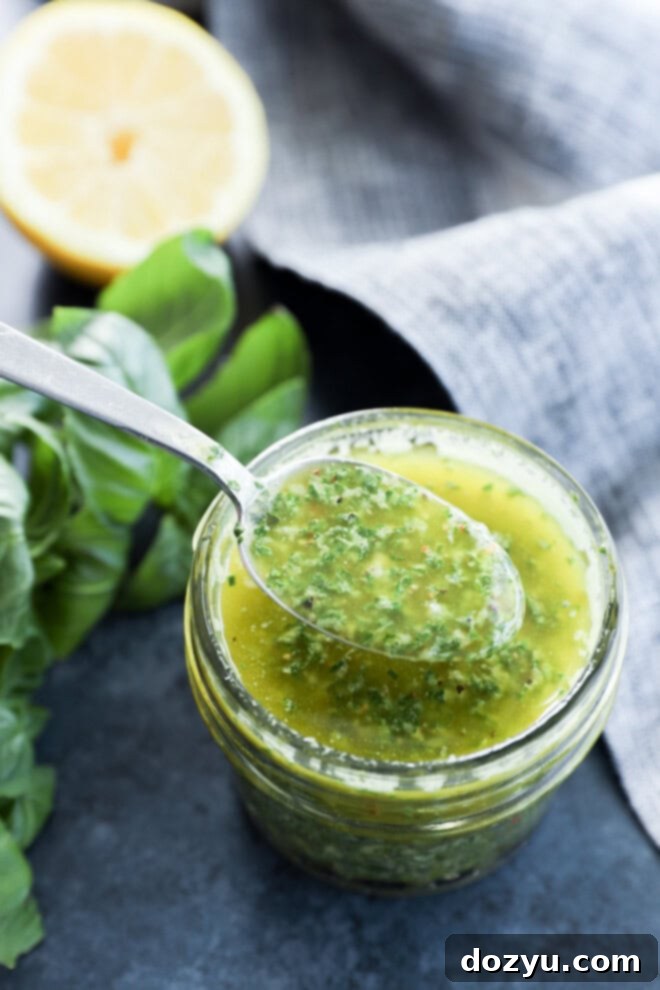
Step-by-Step Guide to Making Basil Oil
Creating this aromatic basil oil is surprisingly quick and simple. Follow these easy steps to whip up your own batch of this versatile condiment.
Blend for Perfection
Begin by gathering all your fresh ingredients. Add the packed fresh basil leaves, mild extra virgin olive oil, peeled garlic cloves, fresh lemon juice, sea salt, and black pepper into the bowl of your food processor. Secure the lid and pulse the mixture. Start with short pulses, then blend continuously until all the ingredients are thoroughly combined and the oil reaches a smooth, consistent texture. For a thinner consistency, ideal for delicate drizzling over finished dishes, gradually add a splash more olive oil until you achieve your desired flow. Be mindful not to over-blend to avoid heating the oil too much, which can sometimes mute the fresh basil flavor.
Customize Your Flavor
Once you have a smooth oil, it’s time for the most important step: tasting and adjusting! Take a small spoonful of your basil oil and assess its flavor profile. Does it need more tang? Add another squeeze of fresh lemon juice. Could it use a little more depth or sharpness? Toss in an additional pinch of salt and/or pepper. For those who love a bit of heat, this is the moment to introduce those red pepper flakes, adding them in small increments until you reach your preferred spicy twist. Don’t be afraid to experiment to make the oil perfectly suited to your palate.
Store for Freshness
Carefully transfer your freshly made basil oil into a clean, dry glass jar that has a tight-fitting, sealed lid. For immediate use, store the jar in the refrigerator, where it will maintain its vibrant flavor and freshness for up to a week. For a brilliant long-term storage solution, consider pouring the basil oil into an ice cube tray. Once frozen solid, pop the basil oil cubes out and transfer them into a freezer-safe bag or container. This allows you to easily portion out exactly what you need, ensuring you always have a burst of fresh basil flavor ready for your meals, whenever inspiration strikes.
Expert Tips and Tricks for Basil Oil
While making basil oil is straightforward, a few expert tips can help you achieve the best flavor and consistency every time:
- Opt for Mild Olive Oil: This is a crucial choice. A light, mild extra virgin olive oil allows the delicate, aromatic notes of the basil to truly sing. Heavy, robust olive oils can easily overshadow the fresh herb, leading to an unbalanced flavor profile. Think of the oil as a canvas for the basil’s art.
- Pack Basil Tightly: When measuring your basil leaves, gently but firmly pack them into the measuring cup. This ensures you’re getting enough basil to create that intense, concentrated flavor you’re looking for. A loosely packed cup won’t yield the same vibrant taste.
- Scrape Down Sides: During the blending process, especially with a food processor, ingredients can stick to the sides of the bowl. Pause occasionally and use a rubber spatula to scrape down any unblended basil or garlic back into the mixture. This ensures an even texture and consistent flavor throughout your oil.
- Achieve Your Desired Consistency: The beauty of homemade basil oil is customizing its texture. If you prefer a thinner, more pourable oil that drizzles beautifully over dishes, simply add a bit more olive oil, a tablespoon at a time, until you reach your ideal consistency. For a thicker, more pesto-like texture, you might use slightly less oil or even add a few nuts (see variations).
- Consider Blanching (Optional for vibrant color): While not strictly necessary for flavor, some chefs briefly blanch basil leaves in boiling water (for 10-15 seconds) and then immediately plunge them into an ice bath before blending. This process helps to set the chlorophyll, resulting in an even brighter green color for your oil that lasts longer. If you prioritize color, this extra step is worth it.
- Prevent Oxidation: Basil oil, especially when stored, can sometimes lose its vibrant green color due to oxidation. To minimize this, ensure your storage jar is airtight. When freezing, pour a very thin layer of neutral oil (like olive or grapeseed) or even lemon juice over the surface of the oil in the tray before freezing. This creates a barrier against air, helping to preserve the color.
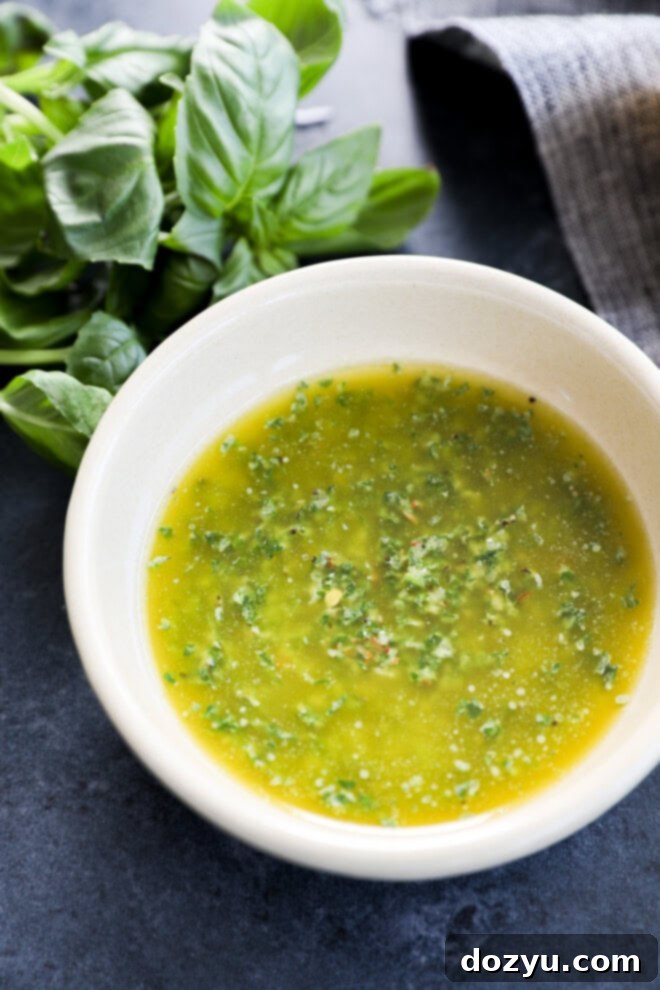
Delicious Basil Oil Variations
The beauty of this basil oil recipe lies in its adaptability. Once you master the basic formula, don’t hesitate to get creative and explore exciting variations to suit different tastes and cuisines:
- Herb Swaps: While basil is the star, you can easily substitute or mix in other fresh herbs. Try fresh parsley for a brighter, slightly peppery oil, cilantro for an oil with a citrusy, pungent kick (great for Mexican or Asian dishes), or fresh mint for a surprisingly refreshing oil perfect for lamb or fruit salads. A blend of basil and parsley is also a fantastic choice.
- Nutty Additions: For added depth, richness, and a thicker texture (leaning towards a pesto-like consistency), blend in toasted nuts. Pine nuts are a classic choice that pairs wonderfully with basil. Walnuts offer a slightly earthier flavor, while almonds provide a buttery undertone. Briefly toasting the nuts before adding them enhances their flavor even further.
- Citrus Twists: Lemon juice provides a bright acidity, but don’t limit yourself! Replace lemon with lime juice for a more tropical-inspired twist that works beautifully with seafood or chicken. Orange zest and a touch of orange juice could also add a subtle sweetness and aromatic lift.
- Spice It Up: If you’re a fan of heat, you can easily enhance the spiciness. Increase the amount of red pepper flakes for a more pronounced kick. For a fresh and fiery note, a small piece of deseeded fresh chili (like a serrano or jalapeño) can be blended in. Adjust to your heat tolerance!
- Cheese Factor: While technically a pesto, adding a handful of grated Parmesan or Pecorino Romano cheese during blending will transform your basil oil into a richer, more savory sauce perfect for pasta or spreading on bread.
More vibrant sauces to explore: Roasted Garlic Aioli | Chili Garlic Oil Recipe | Bang Bang Shrimp Sauce | Easy Sauce for Crab Cakes
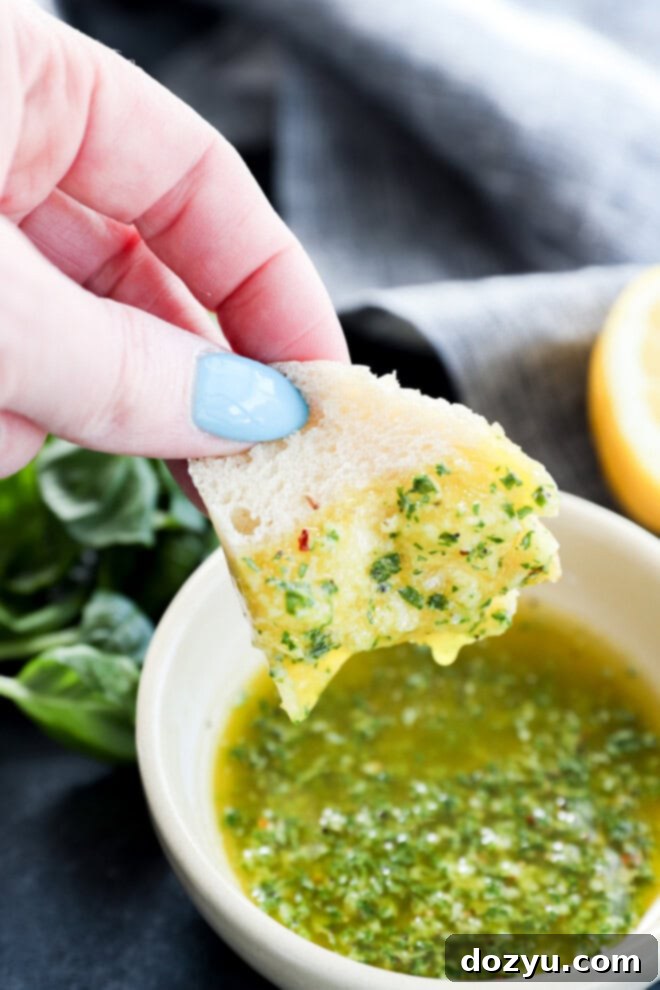
Frequently Asked Questions About Basil Oil
How long does fresh basil last, and how does it affect the oil?
Fresh basil leaves typically maintain their peak quality for about 5-7 days when stored correctly in the refrigerator. To maximize their freshness, trim the stems, place the basil in a glass of water like a bouquet, cover loosely with a plastic bag, and refrigerate. Using fresh, vibrant basil is crucial for this oil because its essential oils are at their most potent. If your basil is wilted or has dark spots, it will yield an oil with a less intense flavor and potentially a duller color. The fresher the basil, the more aromatic and delicious your oil will be.
Can I use dried basil for this recipe?
While dried basil has its place in certain recipes, this homemade basil oil is absolutely not one of them. The entire essence of this condiment relies on the bright, vibrant, and herbaceous burst of flavor that only fresh basil can provide. Dried basil has a much more concentrated, earthy, and sometimes dusty flavor profile that would simply not deliver the refreshing, lively taste that makes this oil so exceptional. For truly outstanding basil oil, fresh leaves are non-negotiable.
What types of basil are best for basil oil?
The world of basil is wonderfully diverse, with each variety offering a unique flavor. For this recipe, we typically recommend sweet basil (also known as Genovese basil) due to its classic, universally loved sweet, peppery, and slightly anise-like notes. However, you’re encouraged to experiment! Thai basil can add a slightly spicier, more licorice-like flavor, while lemon basil brings a bright, citrusy aroma. Purple basil offers a beautiful color (though it might make your oil less vibrantly green) and a slightly milder flavor. Don’t be afraid to try different types to discover which one best suits your culinary preferences and the dishes you plan to serve it with!
What else can I do with leftover basil leaves?
Running out of ideas for that extra basil? Fear not, the possibilities are virtually endless! Beyond this fantastic basil oil, you can whip up a batch of classic homemade pesto, a versatile sauce perfect for pasta, sandwiches, or as a spread. Fresh basil leaves are also incredible for topping off bruschetta, adding a fragrant garnish to pizzas, or incorporating into a fresh caprese salad. For a unique twist, try infusing basil into simple syrup for cocktails or lemonade, or add it to homemade focaccia bread for an aromatic treat. Its fresh flavor truly enhances a wide array of dishes.
Need even more inspiration on what to pair with this glorious oil? Dive into my main dish recipes page for a wealth of ideas!
Serving Suggestions: Endless Uses for Basil Oil
So, you’ve made your batch of vibrant homemade basil oil—now what? The beauty of this flavorful condiment lies in its incredible versatility. Here are countless ideas to inspire you and transform your meals:
- Elevate Vegetables:
- Roasted & Grilled Veggies: Drizzle generously over your favorite roasted or grilled vegetables like asparagus, zucchini, bell peppers, or broccoli for an instant flavor boost.
- Potatoes: It’s a game-changer on crispy smashed fingerling potatoes or even simple baked potatoes.
- Root Vegetables: Try it over honey-roasted carrots and parsnips for a simple yet delicious herbaceous addition.
- Soup & Risotto Enhancer:
- Soups: A spoonful of basil oil swirled into classics like creamy tomato soup, hearty minestrone, or a delicate potato leek soup adds a burst of fresh flavor and a beautiful visual appeal.
- Risotto: Finish off a creamy mushroom risotto or a simple primavera risotto with a swirl of basil oil for an aromatic touch.
- Breakfast & Brunch Boost:
- Eggs: Upgrade your morning eggs! Swirl it into scrambled eggs, drizzle over a fried egg, or incorporate it into your favorite omelet or frittata for a herby, gourmet twist.
- Avocado Toast: A perfect finishing touch for a vibrant avocado toast, adding fresh flavor and a touch of elegance.
- Bread & Dipping:
- Dipping Oil: Pair it with warm, crusty artisan bread or sourdough garlic toast to create a simple yet utterly mouthwatering dipping oil appetizer.
- Bruschetta: Drizzle over freshly made bruschetta for an extra layer of flavor.
- Pasta & Grains:
- Pasta Finisher: Use it to finish a simple pasta dish like pasta napolitana, a rich cacio e pepe pasta, or any light sauce-based pasta for a pop of extra flavor and freshness.
- Grain Bowls: Drizzle over quinoa, farro, or couscous bowls for a herbaceous dressing.
- Protein Power-Up:
- Marinade: If you still have some left, it makes a fantastic, tenderizing marinade for chicken, shrimp, fish, or even tofu before grilling or baking.
- Finishing Touch: Drizzle over baked salmon, grilled chicken breast, or seared scallops just before serving.
- Salads & Sandwiches:
- Caprese Creations: It’s a natural pairing for a vibrant caprese salad (tomatoes, mozzarella, basil) or even caprese sandwiches, enhancing all those classic Italian flavors.
- Salad Dressing: Whisk it into your favorite vinaigrette or use it as a standalone dressing for green salads.
With so many ways to enjoy it, your homemade basil oil is guaranteed to become a new favorite in your kitchen!
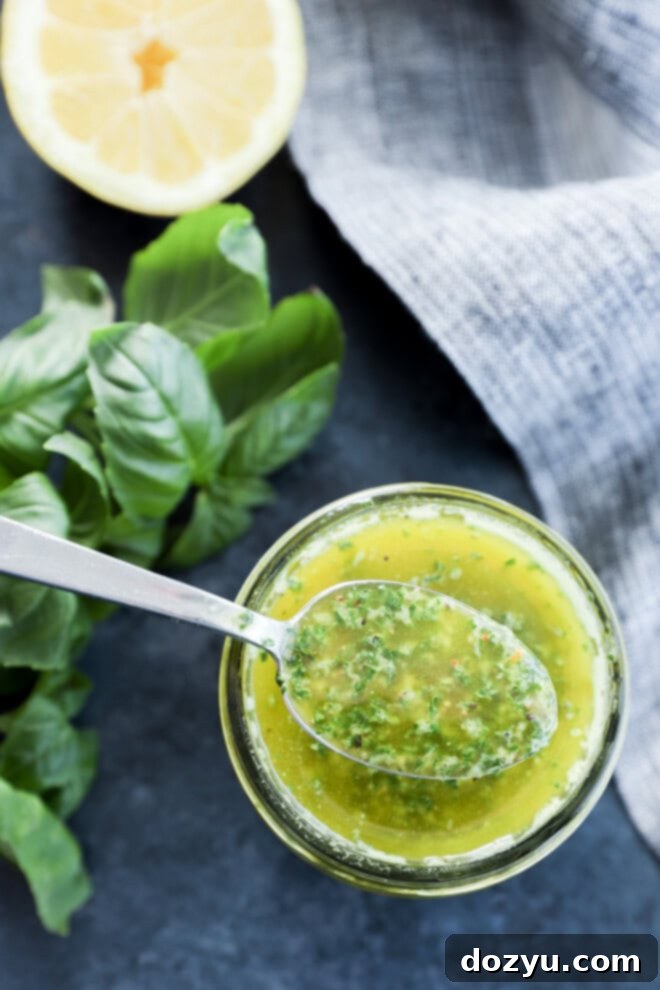
How to Store Your Homemade Basil Oil
Proper storage is key to extending the life and maintaining the vibrant flavor and color of your homemade basil oil. Here’s how to ensure it stays fresh and ready for use:
- Refrigerate: For short-term storage, transfer the basil oil into a clean, airtight glass jar with a tight-fitting lid. Store it in the refrigerator for up to 1 week. While the oil may solidify slightly in the cold, it will return to its liquid state at room temperature or when gently warmed.
- Freeze for Long-Term: Freezing is an excellent option for preserving basil oil for an extended period.
- Ice Cube Trays: Pour the basil oil into ice cube trays and freeze until the cubes are solid. This method allows for convenient, single-serving portions.
- Transfer to Container: Once frozen, remove the solid cubes from the trays and transfer them to a freezer-safe bag or airtight container. This helps prevent freezer burn and makes storage more compact.
- Longevity: Properly frozen basil oil can be stored for up to 6 months without significant loss of flavor.
- Thaw When Ready: When you’re ready to use your frozen basil oil, simply pop a cube or two into a small pan over low heat until it melts, or place it in a bowl and let it thaw at room temperature. For best results and to preserve the freshest flavor, thaw it overnight in the refrigerator.
- Prevent Discoloration: To help prevent the basil oil from losing its bright green color during storage, especially when freezing, you can add a very thin layer of olive oil or a squeeze of lemon juice on top before sealing. This creates a barrier against oxygen, which can cause oxidation and browning.
More Irresistible Recipes to Explore
If you find yourself with an abundance of fresh basil beyond what you need for this incredible basil oil, or if you’re simply looking for more ways to incorporate its fantastic flavor into your cooking, here are some other favorite recipes to inspire you:
- Basil Simple Syrup: This versatile Basil Simple Syrup is a fantastic way to capture basil’s essence in a sweet form. It’s perfect for adding a unique, herbaceous twist to your favorite cocktails, refreshing lemonades, or even drizzling over desserts like fresh fruit or panna cotta.
- Lemon Basil Cooler: Craving a refreshing drink that’s both invigorating and aromatic? Try the Lemon Basil Cooler. This beverage perfectly combines the bright acidity of lemon with the fresh notes of basil for a truly delightful thirst-quencher.
- Burrata Caprese Salad: For an appetizer that consistently impresses with its simplicity and elegance, the Burrata Caprese Salad is always a winner. The creamy burrata, ripe tomatoes, and fresh basil are an iconic trio that showcases the herb beautifully.
And if you’re ever in search of more sauce inspiration to complement your meals, don’t forget to check out these other delicious recipes:
- Roasted Garlic Aioli: A creamy, rich sauce bursting with roasted garlic flavor.
- Chili Garlic Oil: Perfect for adding a spicy, aromatic kick to Asian-inspired dishes or noodles.
- Bang Bang Shrimp Sauce: A creamy and spicy sauce that’s incredibly addictive.
There’s truly no shortage of delicious ways to make the most of your basil bounty and elevate your culinary creations!
Finally, if you try this fantastic basil oil recipe, please be sure to give it a star rating on the recipe card below and/or leave a comment! I absolutely love hearing about your culinary successes and genuinely take the time to respond to every single comment. Your feedback is incredibly valuable!
Feel free to drop any questions you might have in the comments section below, too – I’m here to help!
Oh, and make sure to tag me on Instagram, Facebook, or Pinterest if you make the recipe! It brings me so much joy to see these recipes come to life in your kitchens – looking through your photos is truly my favorite thing. It honestly means the world to me!
Want to be the first to know when I release a new recipe or share the latest news? Sign up for my newsletter to get them delivered straight to your inbox!
Basil Oil Recipe
Made for drizzling, dipping, or cooking. This easy, flavorful recipe is versatile and freezer-friendly!
Prep Time: 5 mins
Total Time: 5 mins
Servings: 10
Pin Recipe
Equipment
- Measuring Cups
- Measuring Spoons
- Food processor (or high-speed blender)
Ingredients
- 3/4 cup fresh basil leaves (packed)
- 1/2 cup mild extra virgin olive oil (more to desired consistency)
- 2 garlic cloves
- Juice of 1/2 medium lemon (freshly squeezed for best flavor)
- 1/2 tsp salt (more to taste)
- 1/2 tsp black pepper (more to taste)
- Optional: pinch of red pepper flakes (for a subtle kick)
Instructions
- Add all the ingredients (basil, olive oil, garlic, lemon juice, salt, pepper, and optional red pepper flakes) to a food processor. Pulse until everything is well blended and smooth. If a thinner consistency is desired for drizzling, add a bit more olive oil, one tablespoon at a time, until preferred consistency is reached.
- Taste the basil oil mixture. Adjust with additional salt, pepper, or lemon juice as needed to suit your personal preference. Add extra red pepper flakes if you desire more heat.
- Transfer the finished basil oil to a clean, sealed glass jar. Store it in the refrigerator for up to 1 week. For longer storage, freeze in small portions (e.g., in an ice cube tray).
Recipe Video
Notes
This recipe yields approximately 2/3 cup of basil oil.
Storage Tips:
- To freeze the basil oil, pour it into a freezer-safe container. To preserve its vibrant color, add a thin layer of olive oil or lemon juice on top before freezing.
- Alternatively, freeze the oil in ice cube trays until solid, then transfer the cubes to freezer-safe bags or containers.
- Basil oil can be stored in the freezer for up to 3 months. Thaw frozen portions overnight in the refrigerator or gently warm in a pan.
Nutrition Information
Serving: 1 Tbsp
Calories: 99 kcal
Carbohydrates: 1g
Protein: 0.2g
Fat: 11g
Saturated Fat: 1g
Polyunsaturated Fat: 1g
Monounsaturated Fat: 8g
Sodium: 117mg
Potassium: 17mg
Fiber: 0.2g
Sugar: 0.1g
Vitamin A: 97 IU
Vitamin C: 3mg
Calcium: 6mg
Iron: 0.2mg
Cuisine: Italian, American
Category: Sauce
